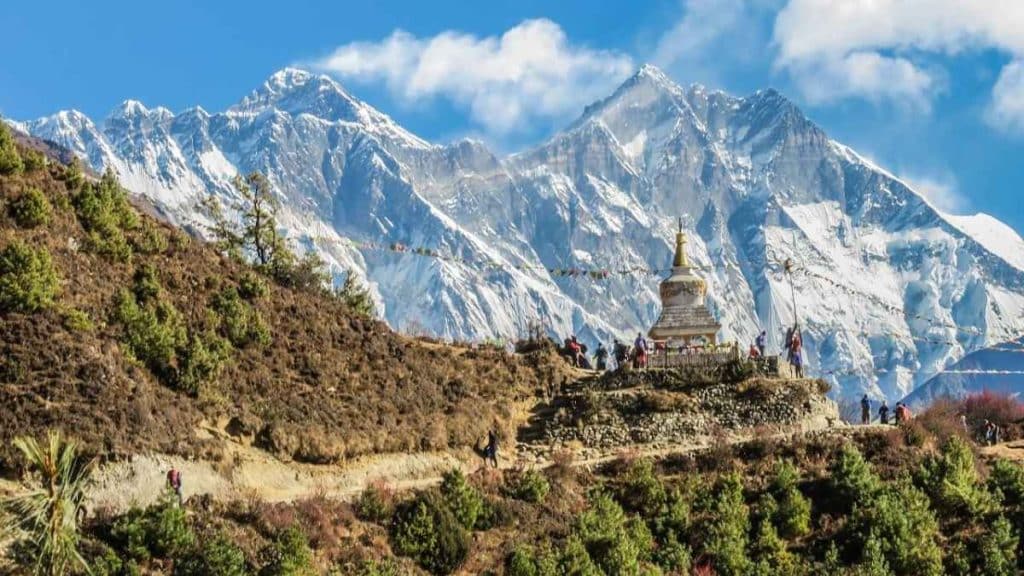If you access the world map, Nepal is a small Himalayan nation in Asia wedged between India to the south and China to the north. From the lowlands to the highlands, and to its towering snow-capped peaks, Nepal’s food, culture, and people are diverse as its geography. With welcoming and friendly people, its hospitality is one of the finest in the world. There is a belief among the people here that ‘Guests are Gods’ and every home is an open door to visitors. It’s the birthplace of Gautam Buddha, home to Mt. Everest, and the land of the Himalayas.
Most are lured to the mountains for trekking and peak climbing; some attempt to scale mount Everest, while others make it to the base camp. One can go trekking in Nepal, peak climbing, jungle safari, elephant ride, bungee jumping, and paragliding among many of adventure sports.
Whether you are an occasional hiker, an experienced mountaineer, or an adventure enthusiast; Nepal is a wonderland full of possibilities that offer unforgettable vacation memories.
Here are the top 5 reasons to visit Nepal once in your lifetime:
1. The land of the Himalayas
Mountains are the jewel of Nepal and Everest is its crown, it is often dubbed by some as the roof of the world. Although Nepal is a small narrow nation, its skyscraping Himalayan summits are unparalleled by any other mountains on earth. It is home to Kanchenjunga, the world’s 3rd highest mountain, Mt. Lhotse 4th highest, and 8 of the world’s 10 highest mountains, among many.
Many of the world-class trekking trails like Everest Base Camp Trek and Kanchenjunga Base Camp Trek center these mountains, making trekking in Nepal a must-do adventure for all backpackers.
2. Birthplace of Lord Buddha
While the Himalayas are mentioned often in the Hindu scriptures- its spiritual immensity was well known long before it was even mapped. It has given birth to Lord Buddha, the light of Asia. Before and after him, many ancient sages have wandered in this land in search of enlightenment.
Whether visiting the religious shrines merely out of curiosity or as part of a quest for spiritual enlightenment and self-discovery, his teachings will undoubtedly improve one’s life one way or another.
3. Diverse Topography
From the plain lands in Terai to the highlands amidst hills, and to its towering mountaintops, Nepal’s topography is both distinctive and captivating. It is home to many endemic and endangered species like snow leopard, one-horn rhino, Asiatic elephants, red-panda, and Royal Bengal Tigers among many others.
The natural settings of Nepal are best for adventure sports. The swift-flowing rivers that flow from the mountains are best for rafting and canoeing. One can undergo rock climbing, paragliding, and bungee jumping. From lush jungles South to Isolated valleys and Rain-shadows in the northern-west, you are welcome to enjoy the countless ecological riches.
4. Cultural Diversity
As mentioned, Nepal’s culture is as diverse as its geography. Nepal is the melting pot of different traditions, cultures, and faiths that co-exists in harmony. There are ethnic indigenous people in each of Nepal’s regions who adhere to their own traditions and customs. In reality, Nepal’s rich cultural heritage plays a significant role in why it is such a desirable location for exotic vacations.
Nepal’s culture manifests in many forms like art, music, festivals, and customs. Every area of Nepal displays culture in a distinctive way. For instance, the fabled Sherpa people reside in Nepal’s Khumbu area, which is also the location of Mount Everest. The Annapurna area is also home to numerous Gurung and Magar villages and settlements. In addition, the Mustang area of Nepal is regarded as one of the world’s final strongholds of pure Tibetan Buddhism.
5. World Heritage Sites
Nepal hosts 10 UNESCO World Heritage Sites. Seven of them are located in Kathmandu Valley alone, making the valley one of the densest concentrations of World Heritage Sites. Every cultural location offers fascinating insights into Nepal’s historical and cultural context.
These royal complexes of Durbar square display architectural riches and the marvel of ancient craftsmanship. The woodwork, metalwork, and stonemasonry on the doors, pillars, and windows of the temples and ancient structures are evidence of the Nepali artists’ unmatched dexterity.
Along with the two UNESCO-listed national parks of Chitwan and Sagarmatha, Nepal is also the birthplace of Gautama Buddha, the source of Buddhism.

